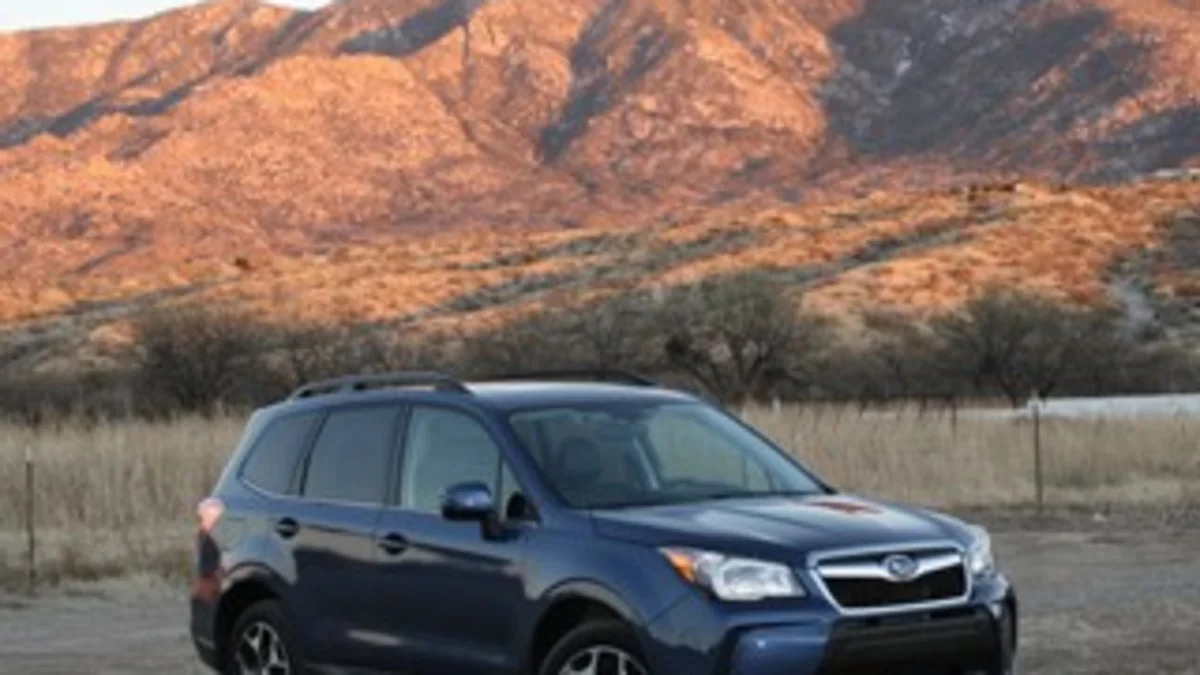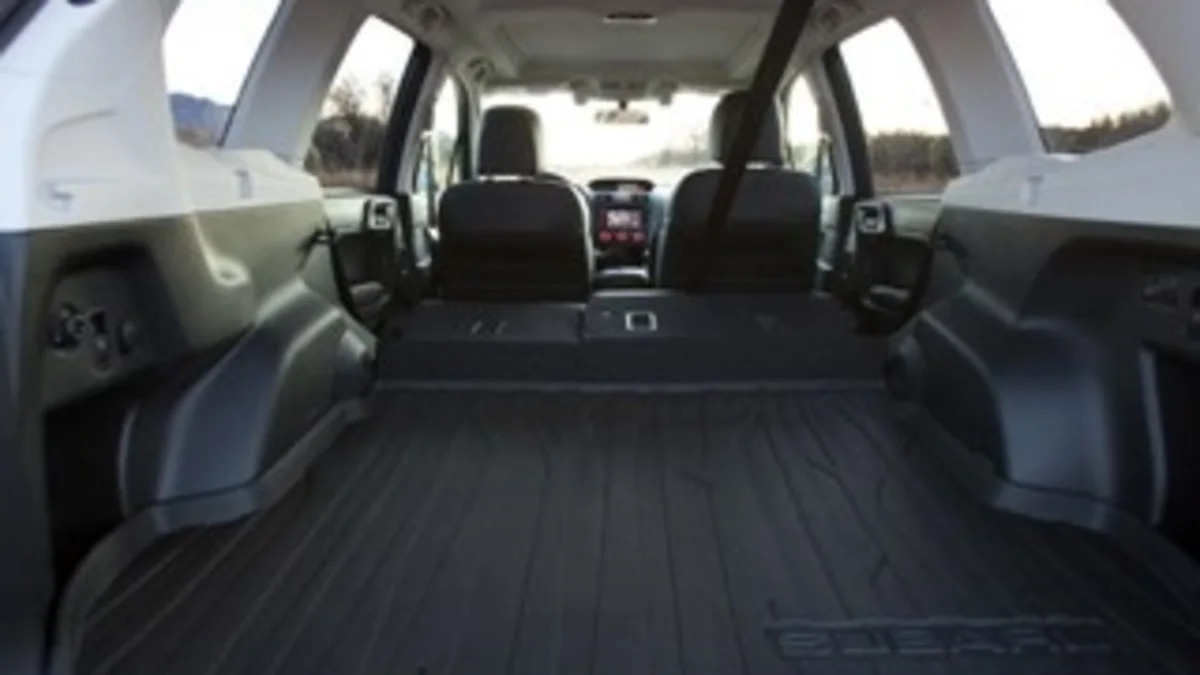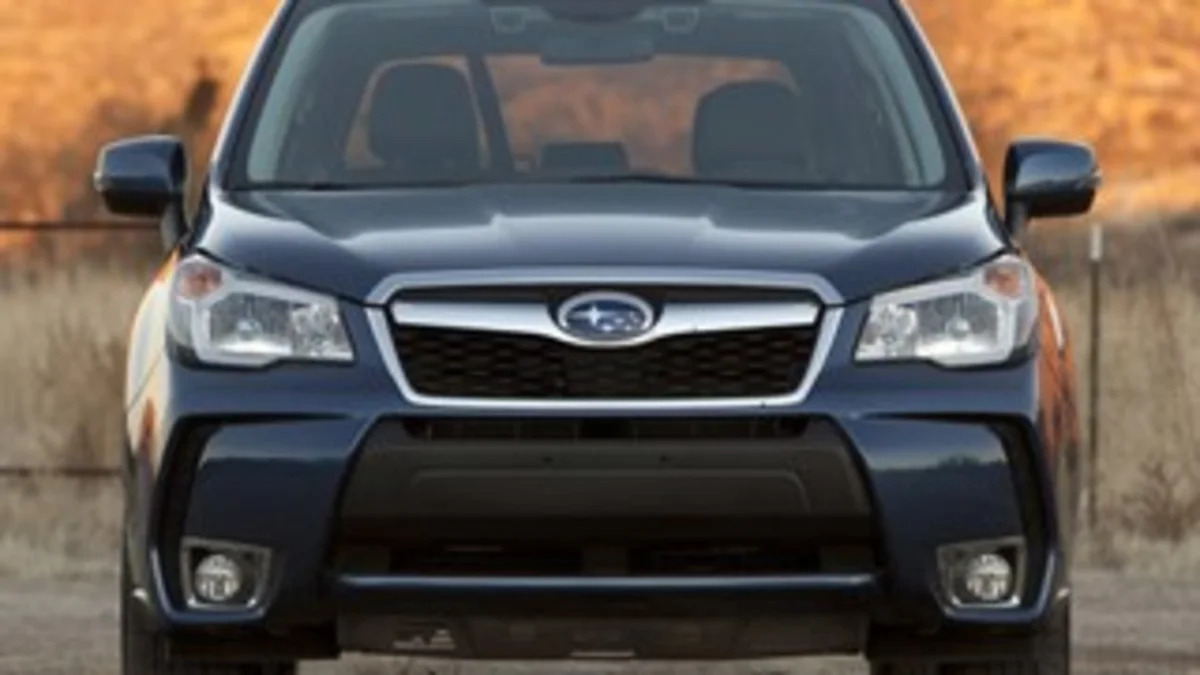2014 Subaru Forester Review

-

The Subaru Forester, with its rugged disposition and all-wheel drive prowess, has long been a favorite in snow-belt states. Turns out, it should also resonate with customers on the brighter side of the country as well.
Here in the Sonoran desert, somewhere southwest of Tucson, Ariz., the latest version of the popular crossover is showing why.
Careening down a dirt road and kicking up dust, the 2014 Forester gives its occupants a surprisingly smooth ride. Blazing across a private racetrack, it flaunts good acceleration and generous stability through tight turns. Climbing up a rocky embankment, it earns some legitimate off-road credibility.
Back in reality, plodding through traffic-clogged Interstate 10, it demonstrates a few features that more practical and less adventurous car buyers will find equally appealing.
The 2014 Forester is significantly different than its previous generation, offering customers a bigger cabin, more cargo space and some serious improvements under the hood and in fuel economy.
From its beginnings as a wagon 13 years ago, this Forester completes the model's transition into a full-fledged crossover. There are substantial changes to appreciate.
One example: Engineers pushed the car's front pillar forward by eight inches and extended the windshield, allowing for great visibility and, once you look past a plethora of dust-choked trailer parks, a beautiful view of the Santa Catalina Range. Subaru lengthened its panoramic moonroof too. Along with a boost in seat height, those alterations give the driver a terrific view, whether its road or scenery.
But it's not only what's outside that makes the Forester a surprisingly fun car to drive, it's what's inside too. There are some technical and performance enhancements that really put the ' 14 Forester, at dealerships in March, at or near the forefront of its crossover class.
Read on to find out how they help the Forester: -
The Basics
MSRP: $22,820 to $33,820
Invoice: $21,995 to $32,995
Engine: 2.5-liter four cylinder that produces 170 horsepower or 2.0-liter turbocharged four-cylinder engine offered in XT models that produces 250 horsepower. The latter is based on the same engine that’s in Subaru’s BRZ sports-car standout.
Transmission: A six-speed manual is offered, though Subaru expects the bulk of its sales to carry its completely redeveloped continuously variable transmission (CVT), an upgrade over its first iteration.
Seating: 5.
Cargo: Capacity increases 9 percent from the Forester’s previous generation to 74.7 cubic feet of space, the best in the CUV class. A caveat: That’s with the rear seats down. With rear seat up, the ’14 Forester ranks third behind the Honda CR-V and Toyota RAV4 in terms of space offered.
Choose a trim level with the panoramic moonroof and approximately 3 cubic feet of space are lost. (Worth the tradeoff, incidentally, unless you plan on utilizing every inch of the space). -
Exterior
The Forester completes its evolution from station wagon to crossover utility vehicle, which makes sense considering America's growing crush on CUVs. In doing so, it grows substantially, which goes against the industry trend of smaller and leaner cars. Compared to the previous model, the '14 Forester is longer, wider, taller and heavier.
Specifically, it is 1.4 inches longer, bringing it closer to the industry average and 1.4 inches taller. The driver's seat has been raised 1.5 inches. Most significantly, there's 8.7 inches of ground clearance, which helps give Subaru some more cred in the off-road department. It's about 240 pounds heavier. To the credit of the Forester's engineers, the growth comes with no ill effects on fuel economy.
The car gets heavier, incidentally, because engineers added a significant amount of high-tensile steel to the front-quartering sides of the vehicle to account for the Insurance Institute for Highway Safety's new small-overlap crash test. It's there to keep occupants safer in one of the most common types of fatal accidents.
Purists will note the XT models get their own distinctive grilles to set them apart from other trim levels. Overall, the exterior design becomes a little less boxy and a little more refined than previous Foresters.
-
Driving Dynamics
In a few short hours of testing, we ripped across curvy dirt roads in the Arizona desert, climbed a rock-strewn hill and twisted around a race track littered with tight turns. In every case, the Forester proved itself to be an utterly stable vehicle.
Even if you're not pushing the car beyond ordinary limits, that blend of stability and versatility will translate nicely for everyday commuters who face a range of weather and traffic conditions.
The redesigned symmetrical all-wheel drive system maximizes traction, and Subaru has added a system called X-Mode that electronically augments the car's all-wheel drive by controlling hill descent at lower speeds and distributing torque across the sides of the car.
Although it comes at a fuel-economy price -- it gets lower gas mileage and Subaru recommends premium fuel, to boot -- the XT Turbo model is tremendous fun to drive. The base CVT model comes with a 0-to-60 time of 9.5 seconds, which felt pretty ordinary. The CVT is more refined than its past iteration. It's an upgrade that prospective buyers should not overlook, but it gets noisy and slightly lags while accelerating at higher speeds.
-
Bottom Line
When you're a mainstream automaker making a mainstream car, it takes some chutzpah to compare your vehicle to both a Porsche Cayenne and a Land Cruiser.
That's what Subaru did during a presentation to reporters, sizing up the Forester's 0-to-60 speed against the Cayenne's and its off-road performance against the Land Cruiser's slope-angle limit.
No one is going to confuse the Forester with those cars. But to Subaru's credit, if there's some weird corner of the universe where German engineering and a mud-spraying SUV intersect to form a durable Japanese automotive offering that can appeal to adventurous spirits and families alike, they have found it.
The Forester and Cayenne have comparable 0-to-60 mph times, and the Forester and Land Cruiser both boast 36-degree slope limits, per Subaru's internal testing. So perhaps it's proper to say that Forester nods to the spirits of those more esteemed vehicles.
Speaking of bravado, it takes even greater gumption to totally gut and redesign a car at the height of its popularity over a 13-year period. We all know the cliché, "If it's not broken, don't fix it."
Subaru ignored that advice, and is better for it, crafting a far better automobile than the outgoing model, one that should appeal to a wide audience.
Consider that Consumer Reports ranked Subaru as the most reliable car brand last year, and along with the Mazda CX-5, the new Forester should be right at the top of any CUV shopping list.



